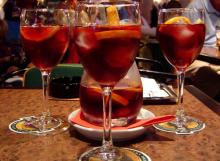When it comes to potables, I'm not a classicist. Wine, liquor, beer and the cocktails we make with them have only been improved with augmented recipes and more informed sensibilities. It was this lack of reverence that changed the Martini from the sour, vermouth-heavy concoction it was in the early 1900's to the crisp, subtle bar standard it is today. It's what transformed scotch from the mediciney rot-gut it was in the 1800's to the pinnacle of craftsmanship it became in the 20th century. Innovation is also what rescued beer from the one-note swill it had been for thousands of years and allowed it become a modern delight of variety and regional flare. That's why I'm not too keen on keeping sangria as close to the classic recipe as possible. Truth is, sangria can be either wonderful or awful and I happen to believe that it's at its best when the recipe gets fiddled with.
First, let's talk about the all-important wine base. My sangria recipe forgoes Spanish wine altogether because, frankly, I don't think it has the right characteristics for the drink. Spanish wine is bold, sharp and about as subtle as a howler monkey. It doesn't dance with other flavor notes because it has no other flavor notes itself, at least when compared to other European wines. It has the roughness of Argentine wine and one-dimensional character of Australian wine. Hitting it with fruit and other flavor agents is pointless because those flavors never really combine.
That said, really complex wine like the French love to make and the full, robust wine that comes out of Italy don't fit the bill, either. For my preferred sangria base, we have to look at the bottom of the Italian shelf. That's where we'll find Lambrusco, the stuff that has been Italy's high-yield table wine since Ancient Rome. Lambrusco is perfect for sangria because it has a slight fizz to it, the alcohol notes are barely noticeable and even its dry varieties are open to fruit flavors. In essence, it's cheap stuff that embraces its cheapness instead of trying (and failing) to be fancy.
Making sangria with bottled fruit juice is a crime, which is where my recipe and the classic recipe agree. As for what fruit to use, my mix prefers the hearty to the tropical. Skip the pineapple, the berries and the stone fruit. They'll all bring too much of their own flavor to the party. Orange, apple, pear and some kind of melon or even mango make for a refreshing but not overpowering mix.
When it comes to the sweetener, I prefer to go natural. Honey is perfect because it brings a distinct, full-mouth flavor without being cloying or sharp. Think of it this way: People eat spoonfuls of honey but not spoonfuls of sugar or simple syrup. It's an even-spreading taste. Also, honey dissolves in cold liquid, unlike sugar.
I'm also not too keen on hitting sangria with a lot of spice. It's not mulled wine. It's supposed to be refreshing. A little vanilla bean, some lemon zest and maybe a tiny amount of ground ginger should do the trick.
All of the above steeped and chilled overnight should suffice, though for a little extra punch feel free to add a small amount of decent brandy to the mix. It shouldn't impart that much flavor but it will raise the alcohol content, if that's what you're aiming for. It's not the traditional recipe but it's also not a crazy derivative. I just think it makes more sense and tastes better.
